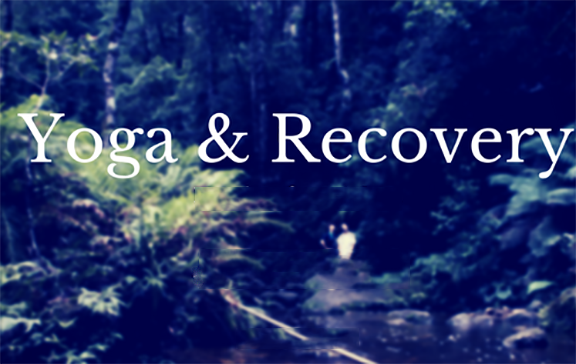 Yoga, combined with 12-Step principles, enhances the recovery process, as both systems complement one another. The additional benefits of a Yoga practice include philosophical and physical components to help guide the practitioner to lifestyle changes that ultimately benefit body, mind and spirit. Examples of how the 12 Steps and philosophical precepts of Patanjali’s Yoga Sutras can be helpful together are shown below.
Yoga, combined with 12-Step principles, enhances the recovery process, as both systems complement one another. The additional benefits of a Yoga practice include philosophical and physical components to help guide the practitioner to lifestyle changes that ultimately benefit body, mind and spirit. Examples of how the 12 Steps and philosophical precepts of Patanjali’s Yoga Sutras can be helpful together are shown below.
I was a child of an alcoholic parent. The disease governed my life, and the effects of it had a tremendous influence over how I lived. This resulted in anxiety, low self-esteem and all kinds of negative traits. In my early 20s I was blessed enough to have stumbled across the Al-Anon program (a 12-Step program for family members of alcoholics). My own healing started when I was able to separate myself from the effects that alcoholism had on my life. I had the 12-Step foundation when I started Yoga.
I gradually began to understand the philosophical precepts of Yoga, and was able to see a bridge between the 12 Steps and Yoga, especially in the whole process of surrendering. I discovered a synergistic effect between the 12-Step process and the ethical precepts of Patanjali. My understanding deepened in the Yoga Teacher Training programs I took. I felt so blessed by what I had come to understand that I knew it was my duty to share the power of Yoga with others in recovery.
The yamas and niyamas (see below) as set forth by Patanjali, invite the seeker to break down old systems of behavior and replace these with new ones that ultimately liberate them from addiction or habits that no longer serve them. Through the physical practice of Yoga one begins to experience how bodily stored tension affects the mind. Those in recovery, soon learn that they have the ability to manage the mechanics of their own body and to create the experience of pranic flow through asana practice, pranayama (yogic breathing) and meditation.
A lot of the teaching about being a 12-Step yogi, is done through example. Not just mine, but also others in the Yoga community. Students see us practicing the yamas and niyamas and catching ourselves when we’re not practicing them. Catching ourselves when we make mistakes is the most important thing. None of us are perfectly practicing the yamas and niyamas all the time. We are just trying to be honest with ourselves in this recovery process. The word recovery is used to mean addictions, but I’ve come to find out that everyone is recovering from something.
I work with so many people who don’t have any understanding of what a Higher Power is. So we start with the body and where they are holding tension. We work with the breath, and it’s a gradual process—easing them through their processes. Everyone is looking for wholeness and a connection with the divine that provides deep peace of mind. Yoga helps us to shed habits that no longer serve us. By seeing things clearly, we can recognize when things are not working for us. This realization begins the process of healing. We may start out thinking Yoga is physical and, as we open, it leads us to a spiritual realm. Yoga allows us to connect on a deeper level, and this is where the healing comes in—through devotion and surrender. We can practice all the asana in the world and we can do it regularly everyday, and we’ll be in great physical shape. Until we begin incorporating the devotional aspects of Yoga, we are not going to experience a full wholeness. Yoga without surrender to God (Ishvara pranidhana) is only part of the process.
I feel so blessed to have had all of the difficulty I’ve had in my life. I recognize that the more tumultuous our lives are, the more we are blessed. In these difficulties there is a real opportunity to grow and to find the divine. When we are sailing along there aren’t as many opportunities. It is helpful to look at our human experiences in a very positive way, and to use our experiences to transform. We want to avoid difficulty. Yet, embracing our own demons and fears allows us to embrace others at the same time. We are all really the same. There are so many people who are really tripped up by our society. They get this idea about how perfect everyone’s lives are, and meanwhile no one’s life is perfect. You don’t know what is going on under the exterior of your neighbors, friends and co-workers. Everyone is experiencing something, and it is important to recognize that we are supposed to have a human experience. There will be drama and chaos. However, we can choose to remain centered in the midst of that. Yoga is not about going from one place to another to escape life, and its difficulties. Yoga is about allowing every day to be a meaningful experience—in light of what is going on around you.
STEP ONE: We admitted we were powerless over our addiction, that our lives had become unmanageable.
Satya (Truth): Acknowledging and confronting one’s personal truth is essential if we want to recover. Empowerment from addiction is only possible when there is truthful acknowledgement that such a condition exists. Otherwise, we remain sick with our secrets, possibly continue to manipulate and play charades with ourselves and others.
STEP TWO: Came to believe that a power greater than ourselves could restore us to sanity.
Brahmacharya (Continence): The insanity of the life of an addict comes from the imbalance caused by overindulgence in the addictive substance or behavior of choice. Brahmacharya is about cultivating self-restraint, restoring balance and remembrance of Brahma, the divine.
Santosha (Contentment): Through the dedicated practice of prayer, Yoga, pranayama and meditation we can learn to become more content in all situations. We gradually become less reactive and more content with any given situation that might arise, especially in the midst of difficulty.
STEP THREE: Made a decision to turn our will and lives over to the care of God as we understood God.
Isvara Pranidhana (Surrender): Through cultivated practice and discipline, we begin to embrace the concept of surrender to God. When surrender is practiced, it opens the door to allow the flow of grace to enter our lives; we become more relaxed and at ease with our lives. Over time, we realize that being able to let go is more self-empowering than holding on or gripping too tightly for control.
STEP FOUR: Made a searching and fearless moral inventory of ourselves.
Svadhyaya (Self-study): A personal commitment of self-study on a regular basis invites us to explore and examine our behavior, motives toward ourselves and others.
STEP FIVE: Admitted to God, to ourselves and to other human beings the exact nature of our wrongs.
Ahimsa (Non-violence): The practice of non-violence toward ourselves or others is practiced with compassion. If we acknowledge an apology for wrongdoings to God, self and others, we can expect to be forgiven, put our shortcomings behind us and move into the present with the intention to never repeat that hurtful act.
STEP SIX: Were entirely ready to have God remove all these defects of character.
Saucha (Purity): To practice purity and cleanliness in all aspects of body, mind and spirit creates space to receive God’s blessings to remove all character defects and destructive patterns of behavior.
STEP SEVEN: Humbly asked God to remove our shortcomings.
Tapas (Austerity): We become humble enough to recognize the time has come to truly purify our old patterns of behavior. We seek divine guidance to modify thought, word and deed.
STEP EIGHT: Made a list of all persons we had harmed, and became willing to make amends to them all.
Satya (Truth): When we are willing to truthfully acknowledge the persons we have inflicted harm onto—intentional or not—this is an important component of the healing process.
STEP NINE: Made direct amends to such people wherever possible, except when to do so would injure them or others.
Tapas (Austerity): When we deliberately intend to purify ourselves, we include our past, by making amends to others. This is often the passageway to possibility for both individuals to forgive, heal and move on.
STEP TEN: Continued to take personal inventory and when we were wrong promptly admitted it.
Svadyaya (Self-study): The recovery process is a lifelong journey that requires regular examination and study of self, including behavior and intention.
STEP ELEVEN: Sought through prayer and meditation to improve our conscious contact with God as we understood God, praying only for knowledge of God’s will for us and the power to carry that out.
Isvara Pranidhana (Surrender): Daily devotion to a committed practice of Yoga, meditation, prayer and the twelve steps will ultimately lead our actions to the supreme act of surrender to the will and grace of God.
STEP TWELVE: Having had a spiritual awakening as a result of these steps; we tried to carry this message to others, and to practice these principles in all our affairs.
Aparigraha (Non-possessiveness): When we experience a spiritual awakening, we realize it is our dharma, or duty, to share these practices with others and there is freedom from hoarding. We then become the teacher through example, as we practice these 12-Step principles accompanied with Yoga, meditation and prayer.

About the Author:
Tamara Page, RYT, has been a longtime practitioner of Yoga and a teacher since 1997. In addition, Tamara holds a certification in hypnosis through the National Guild of Hypnotists. Tamara is the founder of Discover & Recover® Yoga, an organization promoting wellness of body, mind and spirit through the practices of Yoga, meditation, devotional chanting and hypnosis.
(Article originally appeared in Integral Yoga Magazine, Summer 2009)


